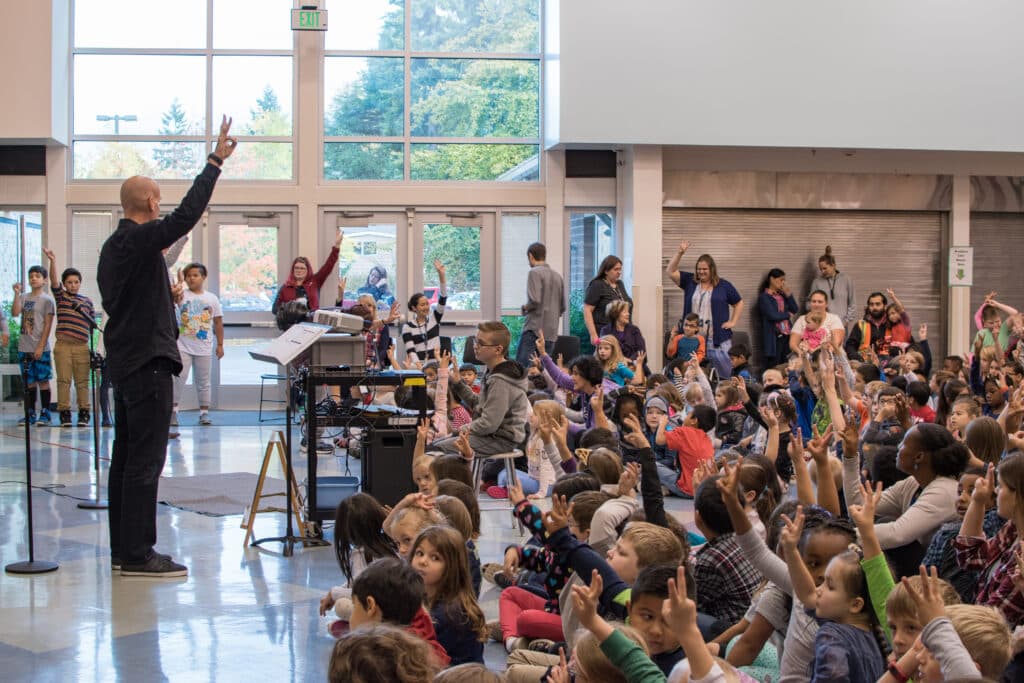
During my thirty-nine-year teaching career, I’ve walked school hallways in five states and taught many students in public, private, and parochial settings. Over all those years, I’ve seen the power of group gatherings—whether daily, weekly, or monthly. In schools where those gatherings are purposeful, fun, and tied closely to the curriculum, I’ve seen the social-emotional and academic learning that’s happening in classrooms concentrate in the gatherings and then ripple throughout the school. That rippling is obvious as students move from one realm to another: from the classroom to the art room, the art room to the playground, the playground to the lunchroom, then back to the classroom, and finally onto the bus.
Sounds like magic, doesn’t it? In a way, it is. But it’s a practical magic that can happen anywhere when administrators and staff work together to plan gatherings that fit their students and their school. Here are some tried-and-true tips for success.
Designing effective gatherings requires collaboration and commitment from many people. School leaders must provide clear direction, and all the adults throughout the building—administrators, teachers, and other staff—must work together to:
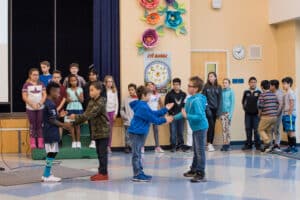
As far as naming your event, I’ve seen them called “assembly,” “gathering,” “meeting,” “whole-school,” “all-school”—you might mix and match those terms or come up with new ones that sound right for your school. The name matters less than how you describe the events to students and what they do when they’re there. The team’s most important consideration: Designing the gathering in such a way that teachers see the value of putting time aside to plan for and participate in it.
To help standardize the format of your gathering, no matter which grade or group is planning and leading it, you may want to use a planning sheet like this one:
Date: __________ Attendees (grade levels): ______________
Start time: _______ End time: _______ Set-up time: _______
Location: __________________________________________
Contact persons: ____________________________________
Components (if using Morning Meeting format, specify greeting, sharing, group activity, and messages): __________________________________________
Audio-visual and other technical needs: __________________________________________
Should you involve the whole school or only a subset? Meeting logistics naturally become more complex with larger numbers of students, so it may not be feasible for every gathering to involve the whole school if you have a very large student body.
But you can realize similar benefits by sharing learning and celebrating achievement in smaller community segments, such as by grade levels or by learning groups. For example, in a dual-language immersion school, the English/Chinese students and the English/Spanish students could each have their own weekly gatherings as well as participating in monthly whole-school gatherings.
I know of a large elementary school that gathers students in the gym for monthly meetings by grade level. (To give you a sense of scale, they have ten fifth grade classes.) The school has chosen to follow the Morning Meeting format familiar to students from their classrooms. As different classes take seats in concentric circles, one class assumes responsibility for each of four meeting components: greeting, sharing recent classroom work, an activity that engages everyone (such as a birthday song or two for those celebrating birthdays that month), and messages relevant to upcoming grade-level activities. With careful planning, the grade levels complete their meetings in about twenty-five minutes.
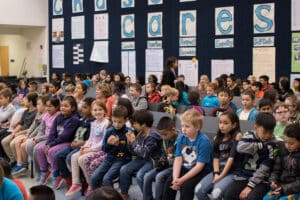
Whole-school meetings require extra planning, communication, and coordination, but they offer unique opportunities for students of all ages to get to know one another, which can make school feel safer for everyone. Younger students gain confidence as they take their turn leading the meetings; older students learn how to include and support younger schoolmates as they plan meetings that are accessible to everyone.
Should you meet daily, weekly, or monthly? A key factor in your decision will likely be the size of your student body. I know of some very small schools (one has just sixty students in grades K–5) that gather all students together every day. They do this as a way of reaffirming their community and setting the tone for their day of learning. (See In Our School: Building Community in Elementary Schools for a description of this and other schools’ gatherings.)
Some schools schedule gatherings each Friday to mark the end of another week of learning. In just a few minutes, students connect with each other and review their learning in a fun way. In one such school, students sing songs they’ve all learned. Then classes take turns briefly presenting recent learning and leading a quick activity or greeting.
And some schools, especially those that gather the whole school community together at one time, schedule monthly meetings, each led by a class or grade level.
Do you have an assembly every January to honor Dr. Martin Luther King Jr.? Celebrate literacy by gathering in the gym, sharing hot chocolate, and having a read-in? If so, you’re establishing traditions—experiences everyone remembers and anticipates—that help grow your community. These traditions can be the familiar stuff from which you build your first gatherings.
At my school in Colorado, for example, one tradition is for the kindergartners to study cowboy and cowgirl culture. Everyone looks forward to the all-school “rodeo” celebration when the cowboys and cowgirls ride their stick ponies and share their Wild West learning.
Make sure to plan group experiences that relate to and extend students’ current classroom learning. For example, students can:
The possibilities are truly endless! Just remember that the academics must be accessible to everyone at the gathering. Planners will need to scale the complexity to fit all grade levels attending.
Back in their classrooms, teachers can enhance the academic benefits by taking a few minutes for students to share what they learned at the gathering.
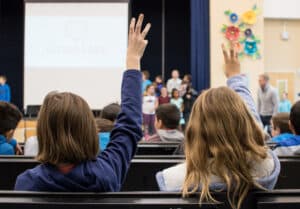
The ultimate aim of school gatherings is to create a comfortable, safe, and predictable environment where students can have fun and get to know one another while also burnishing their academic learning. To achieve that aim, students need to know what to expect at a gathering. Perhaps they’ll always begin with the Pledge of Allegiance, the school song, or a favorite greeting. Keeping the format simple and predictable, and being conscious and respectful of time parameters, helps ensure successful meetings.
Schools in which classrooms hold Morning Meetings often choose to build on students’ familiarity with the Morning Meeting structure by using it, perhaps in an adapted format, for their larger gatherings. The behavioral expectations for classroom meetings can translate to the larger setting, and structuring gatherings around the four meeting components of greeting, sharing, group activity, and a written morning message eases the planners’ task and helps keep everyone on schedule.
A couple of things to consider if you choose to use the Morning Meeting format:
Once you’ve established the general content and format, vary the individual elements enough to keep things fun and fresh. These variations can be as simple as swapping out the song you sing together to start or end your gathering.
Gatherings are less demanding when teachers know in advance when they and their students will be hosting and have time to plan and practice. Some schools create the entire hosting schedule at the start of the year and figure planning time into the school schedule. Others have hosts sign up for monthly slots whenever they’re ready and arrange planning and practice time accordingly.
No matter how you schedule hosts and arrange their preparation time, the goal is to encourage everyone to take a turn hosting and to support them in doing so.
In students’ individual classrooms, before they meet in larger groups, they should practice the expected large-gathering behaviors so that they are set up for success. In our school, for example, classroom teachers explicitly teach students that applause is appropriate for performances whereas hooting can be appropriate for sporting events. Teachers also model what appropriate applause will look and sound like and provide students with opportunities to practice “audience behaviors” in the classroom during daily activities. In many classrooms, students applaud sharers and writers when they stand before the group. This model then carries into larger gatherings.
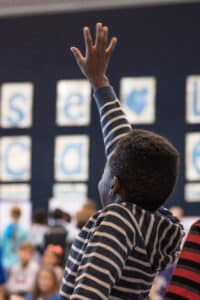
How do teachers and students enter the gathering space, where do they sit, and how do they leave? Decide on organized ways to gather and dismiss students, and teach students to wait for directions.
At some schools, music plays in the background as students arrive quietly and take their seats in designated spots. Other schools have older students pick up partners from a younger grade and then sit with them during the gathering.
At dismissal, leaders can release students by class or, in very small schools, by grade level or by category: “Walk to your classroom now if you had cereal for breakfast” (or “if you’re wearing shoes with laces,” etc.). Category dismissals give students a little extra practice in listening as they wait to hear their cue.
Following each gathering, the planning team should meet to reflect on how future gatherings could be improved. Key topics:
Well-planned school gatherings provide opportunities beyond the classroom for learning and achievement. Students learn to translate classroom behavior expectations into audience behaviors, practice leadership and public speaking, and grow a vision of themselves as contributing members of a larger community.
Greeting teachers in the hall, saying “hi” to the receptionist, acknowledging a student who led an assembly, showing excitement back in the classroom over something learned from fellow students at a school gathering—all are examples of how such gatherings can spread community values throughout the school and motivate students to do their best. For most schools, successful gatherings don’t happen overnight. They take planning, persistence, and a willingness to experiment, regroup, reflect, and try again. But I think you’ll find the results well worth the effort.
Susie Cook is a Responsive Classroom teacher.